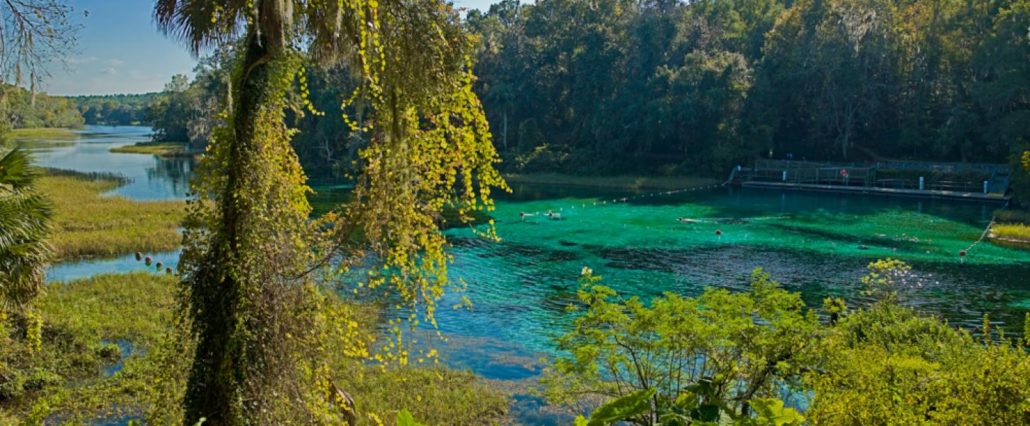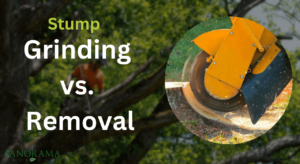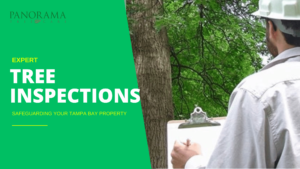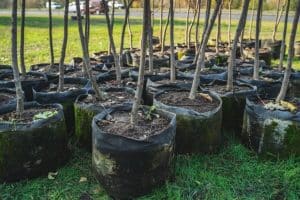Taking care of trees in Florida requires a year-round effort due to the state’s unique climate.
Our weather ranges from hot, humid summers to mild winters, with the occasional cold snap and hurricane threat.
This variety makes seasonal tree care essential for maintaining healthy and beautiful trees.
Importance of Seasonal Tree Care in Florida
Florida’s diverse climate means that trees here face different challenges throughout the year.
From heavy rains and strong winds to intense heat and sudden cold spells, each season brings its own set of conditions.
Proper seasonal tree care ensures that trees can withstand these changes, grow strong, and stay healthy.
Spring Tree Care (March – May)

Post-winter Inspection and Pruning
As winter comes to an end, it’s important to inspect your trees for any damage caused by the colder weather.
Winter can be tough on trees, leading to broken branches, cracks in the bark, or other structural issues.
This inspection helps you identify these problems early, allowing you to take action before the tree’s spring growth spurt.
Pruning is a key activity during this time. Removing dead or damaged branches helps the tree focus its energy on producing new, healthy growth.
Pruning also improves the tree’s shape and structure, reducing the risk of disease and pest infestations.
Be sure to use proper pruning techniques to avoid harming the tree. Cutting branches correctly promotes faster healing and minimizes the chances of introducing diseases.
Fertilization Techniques for Spring Growth
Spring is a time of rapid growth for trees. After a period of dormancy in the winter, trees are ready to burst into life.
Providing the right nutrients through fertilization is crucial to support this growth. Fertilizing your trees in the spring ensures they have all the necessary nutrients to develop strong roots, lush foliage, and vibrant flowers.
Use a balanced fertilizer that contains nitrogen, phosphorus, and potassium. These nutrients are essential for overall tree health.
Nitrogen promotes leafy growth, phosphorus supports root development, and potassium enhances disease resistance.
Applying fertilizer correctly, according to the tree species and soil conditions, maximizes its benefits.
Pest Control Measures for Common Spring Tree Pests
Spring is also a time when many pests become active. Aphids, caterpillars, and other insects can cause significant damage to trees if not controlled early.
These pests feed on the new growth, weakening the tree and making it more susceptible to diseases.
Implementing pest control measures early in the season helps prevent infestations. Regularly inspect your trees for signs of pests, such as discolored leaves, holes in foliage, or sticky residue.
Use eco-friendly pest control methods like introducing beneficial insects, applying insecticidal soaps, or using horticultural oils. These methods are effective and minimize harm to the environment.
Preparing Trees for Hurricane Season
In Florida, preparing trees for hurricane season is a crucial part of spring tree care. Hurricanes can cause severe damage to trees, leading to broken branches or even uprooted trees.
Taking steps to strengthen your trees before the hurricane season begins in June can significantly reduce the risk of damage.
Pruning plays a vital role in hurricane preparation. By removing weak or dead branches, you reduce the wind resistance of the tree, making it less likely to break during a storm.
Additionally, check for weak spots in the tree’s structure, such as splits or decayed areas. Addressing these issues early can prevent catastrophic failures during high winds.
Consider cabling or bracing large branches that could pose a hazard. These techniques provide additional support and reduce the chances of branches breaking.
Consulting with a professional arborist can help you determine the best approach for preparing your trees for hurricane season.
Summer Tree Care (June – August)

Summers in Florida are characterized by intense heat, frequent storms, and sometimes prolonged dry periods.
Taking proper care of your trees during these months ensures they remain healthy and resilient despite the harsh conditions.
Watering Strategies During Hot, Dry Periods
In the summer, the key to maintaining healthy trees is ensuring they receive adequate water. However, it’s important to water correctly to promote strong root systems and overall tree health.
- Deep Watering: Instead of shallow, frequent watering, opt for deep watering. This involves soaking the soil to a depth of at least 12 inches. Deep watering encourages trees to develop deep root systems, which helps them access moisture during dry periods and makes them more stable.
- Frequency: Water your trees deeply once or twice a week, depending on the weather conditions and soil type. Sandy soils drain quickly and may require more frequent watering, while clay soils retain moisture longer.
- Timing: The best time to water is early in the morning or late in the evening. This minimizes water loss due to evaporation and ensures the trees can absorb the maximum amount of water.
Mulching Techniques to Retain Moisture
Mulching is a simple yet highly effective method to help trees retain moisture, regulate soil temperature, and reduce weed competition.
- Type of Mulch: Use organic mulches such as wood chips, bark, or compost. These materials not only help retain moisture but also improve soil fertility as they decompose.
- Application: Apply a layer of mulch about 2-4 inches thick around the base of the tree, extending out to the drip line (the area under the tree canopy). Be sure to keep the mulch away from the trunk to prevent rot and pest problems.
- Benefits: Mulching reduces the need for frequent watering, keeps the soil cooler in hot weather, and suppresses weed growth that competes with the tree for nutrients and water.
Monitoring for Heat Stress and Sunscald
Summer heat can be stressful for trees, leading to issues like heat stress and sunscald. It’s important to monitor your trees regularly and take action to protect them.
- Heat Stress Signs: Look for symptoms like wilting leaves, yellowing, or browning leaf edges. Trees may also drop leaves prematurely or show signs of stunted growth.
- Sunscald: This condition occurs when the bark heats up too much, causing damage. It often affects young trees or those with thin bark. Signs include cracked or peeling bark on the sun-exposed side of the tree.
- Protection Measures: For heat-stressed trees, increase watering and consider providing shade using shade cloths or temporary structures. For sunscald, wrap the trunks of vulnerable trees with tree wrap or paint them with white latex paint diluted with water to reflect sunlight.
Storm Preparation and Damage Prevention
Florida’s summer also brings the risk of storms and hurricanes. Preparing your trees for these events is crucial to prevent damage.
- Structural Inspection: Regularly inspect your trees for structural integrity. Look for weak branches, cracks, or signs of decay. Pay special attention to older trees and those with a history of damage.
- Pruning: Remove dead, diseased, or weak branches that could break during a storm. Pruning reduces the tree’s wind resistance and prevents large limbs from falling.
- Cabling and Bracing: For large branches that could pose a risk, consider cabling or bracing. These techniques provide additional support and stability, helping to prevent breakage during high winds.
- Post-Storm Care: After a storm, check your trees for damage. Remove any broken branches and monitor the tree’s health closely. If a tree has suffered significant damage, consult a professional arborist for advice on whether it can be saved or needs to be removed.
Fall Tree Care (September – November)

As the temperatures start to cool down, fall is a crucial time to prepare your trees for the upcoming winter months.
Pruning and Removing Damaged Branches
Fall is an excellent time to prune your trees. Pruning in the fall helps to remove any damaged or dead branches that could become hazardous during winter storms. Here’s how to approach it:
- Assessment: Begin by inspecting your trees for any signs of damage or disease. Look for branches that are dead, broken, or diseased. These branches are more likely to break during a storm, posing a risk to the tree and surrounding property.
- Pruning Techniques: Use clean, sharp tools to make precise cuts. For small branches, use pruning shears, and for larger branches, use a pruning saw. Cut branches at a slight angle just outside the branch collar (the swollen area where the branch meets the trunk) to promote proper healing.
- Shaping: Pruning also helps shape the tree, promoting better air circulation and light penetration. This encourages healthy growth and reduces the risk of fungal infections.
Fall Fertilization Methods
Fertilizing trees in the fall can help them store essential nutrients for the winter and prepare for vigorous growth in the spring. Here’s what you need to know about fall fertilization:
- Choosing the Right Fertilizer: Use a slow-release fertilizer that provides a steady supply of nutrients over time. Look for a balanced formula that contains nitrogen, phosphorus, and potassium. These nutrients support overall tree health and root development.
- Application: Apply the fertilizer evenly around the drip line of the tree (the area under the outer circumference of the tree branches). Avoid placing the fertilizer directly against the trunk to prevent root burn.
- Timing: Early fall is the best time to fertilize trees. This allows them to absorb the nutrients before the soil temperature drops too much, ensuring they have enough reserves to survive the winter.
Preparing Trees for Cooler Weather
As temperatures begin to drop, it’s important to prepare your trees for the cooler weather. Here are some steps to take:
- Check Soil Moisture Levels: Make sure your trees are well-watered before the first frost. This helps prevent stress and damage during the colder months. Water deeply and thoroughly to ensure the roots have adequate moisture.
- Mulching: Apply a layer of mulch around the base of the tree to insulate the roots and retain soil moisture. Use organic materials such as wood chips, straw, or compost. A 2-4 inch layer of mulch is ideal, but be sure to keep it away from the trunk to avoid rot and pest problems.
Planting New Trees: Best Practices and Timing
Fall is an excellent time for planting new trees in Florida. The cooler temperatures and increased rainfall create optimal conditions for new trees to establish strong root systems before the heat of summer. Here’s how to plant new trees successfully:
- Choosing the Right Species: Select tree species that are native or well-suited to Florida’s climate. Native trees are more resilient to local pests, diseases, and weather conditions. Some good options include live oak, Southern magnolia, and bald cypress.
- Planting Techniques: Dig a hole that is twice as wide and just as deep as the tree’s root ball. Place the tree in the hole, making sure the top of the root ball is level with the surrounding soil. Backfill the hole with the excavated soil, and water thoroughly to eliminate air pockets.
- Aftercare: Water the newly planted tree regularly to help it establish roots. Apply mulch around the base to retain moisture and protect the roots. Avoid fertilizing new trees immediately after planting, as this can stress them. Instead, wait until the following spring to begin a regular fertilization schedule.
Winter Tree Care (December – February)
- Protecting sensitive trees from occasional cold snaps: Cover sensitive trees or bring potted trees indoors during cold snaps to prevent damage.
- Winter pruning techniques: Pruning in winter is ideal for many tree species as it minimizes sap loss and reduces the risk of disease.
- Monitoring for winter pests and diseases: Even in winter, pests and diseases can affect trees. Regular inspection helps catch issues early.
- Planning for spring growth: Use the winter months to plan for spring. Consider which trees might need additional care or treatment as the weather warms.
Year-round Tree Care Tips for Florida
Taking care of your trees is a year-round responsibility, especially in Florida, where the climate can be challenging.
Here’s a detailed guide on essential tree care practices to keep your trees healthy throughout the year:
Regular Inspection Schedule
Regular inspections are crucial for maintaining the health of your trees. Establish a routine to inspect your trees each season.
This helps you catch problems early before they become severe.
- Spring Inspection: Check for any damage from winter storms, such as broken branches or signs of disease. Look for new growth and ensure the tree is coming out of dormancy correctly.
- Summer Inspection: Monitor for heat stress, sunscald, and signs of pests or diseases. Pay attention to the tree’s foliage, as yellowing or wilting can indicate problems.
- Fall Inspection: Look for any branches that need pruning before winter. Check the soil moisture and ensure the tree is well-prepared for cooler temperatures.
- Winter Inspection: Even in Florida, trees can suffer from cold snaps. Check for frost damage and ensure sensitive trees are protected.
Proper Pruning Techniques
Pruning is essential for encouraging healthy growth, maintaining the tree’s structure, and reducing disease risk. Here’s how to do it properly:
- Tools: Use clean, sharp tools to make precise cuts. Pruning shears are suitable for small branches, while a pruning saw is better for larger limbs.
- Timing: Prune trees at the appropriate times. For most trees, late winter to early spring is ideal, but some trees may benefit from pruning after they have finished flowering.
- Method: Remove dead, diseased, or damaged branches first. Cut branches at a slight angle just outside the branch collar to promote proper healing. Avoid over-pruning, as this can stress the tree and make it more susceptible to diseases and pests.
- Shaping: Pruning also helps shape the tree, allowing better air circulation and sunlight penetration. This reduces the risk of fungal infections and encourages strong, healthy growth.
Soil Management and Root Care
Healthy soil is the foundation for strong, vibrant trees. Managing soil health involves regular testing and proper care practices:
- Soil Testing: Conduct soil tests to determine its pH and nutrient levels. This information helps you understand what your soil needs to support healthy tree growth.
- Fertilization: Based on soil test results, apply the appropriate fertilizer. Use a balanced fertilizer that provides essential nutrients like nitrogen, phosphorus, and potassium. Follow the recommended application rates to avoid over-fertilizing, which can harm the tree.
- Watering: Proper watering is crucial. Water deeply and less frequently to encourage deep root growth. This helps trees withstand dry periods. The best time to water is early in the morning or late in the evening to minimize evaporation.
- Mulching: Apply mulch around the base of the tree to retain soil moisture, regulate temperature, and reduce weed competition. Use organic mulch like wood chips or compost. Apply a 2-4 inch layer, but keep it away from the trunk to prevent rot and pest problems.
Importance of Choosing Native and Florida-Friendly Tree Species
Selecting the right tree species for your landscape is essential for long-term success. Native and Florida-friendly trees offer numerous benefits:
- Adaptation: Native trees are adapted to local conditions, making them more resilient to Florida’s climate challenges, such as humidity, heat, and occasional cold snaps.
- Low Maintenance: These trees require less maintenance compared to non-native species. They are better suited to the local soil and weather conditions, reducing the need for extra watering, fertilization, and pest control.
- Pest and Disease Resistance: Native trees are more resistant to pests and diseases common in Florida. This reduces the need for chemical treatments and makes tree care easier.
- Ecological Benefits: Planting native trees supports local wildlife, providing habitats and food sources for birds, insects, and other animals. It also helps maintain the natural ecosystem balance.
Year-Round Benefits
By following these year-round tree care tips, you ensure your trees remain healthy, vibrant, and resilient.
Regular inspections, proper pruning, soil management, and choosing the right species are all crucial steps in maintaining a beautiful and thriving landscape.
Consistent care helps prevent problems before they become severe, ensuring your trees contribute to your property’s beauty and value for years to come.
With Florida’s ever-changing climate, homeowners benefit most from year-round tree services in Tampa that adapt to each season’s challenges—ensuring your trees thrive, no matter the weather.
When to Call a Professional
- Signs that indicate need for expert intervention: If you notice significant damage, disease, or pest infestations, it’s time to call a professional.
- Benefits of professional tree care services: Professionals have the expertise and equipment to handle complex tree care tasks safely and effectively.
- How Panorama Tree Care can help maintain your trees: At Panorama Tree Care, we offer comprehensive tree care services tailored to the needs of Tampa Bay residents, ensuring your trees thrive all year long.
From spring pruning to storm-season preparation, our seasonal tree maintenance services Tampa are designed to keep your landscape safe, healthy, and visually stunning all year long.
Conclusion
Keeping your Florida trees healthy means staying ahead of seasonal changes with consistent, proactive care. With the right approach—and expert guidance when needed—you can ensure your trees thrive year-round.
Let the professionals at Panorama Tree Care help you protect and enhance your landscape through every season.
Contact us today to schedule your personalized tree care service and keep your trees in peak condition all year long.







